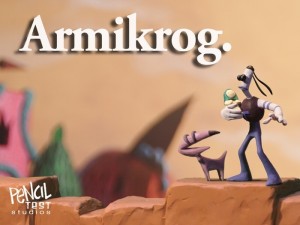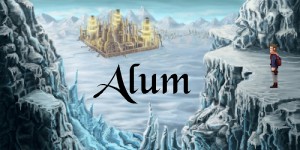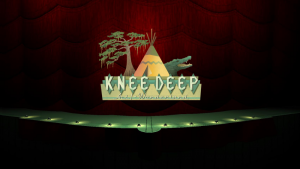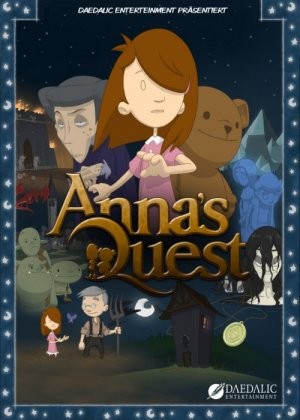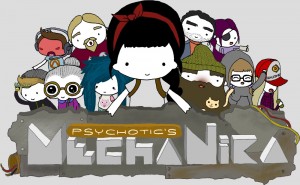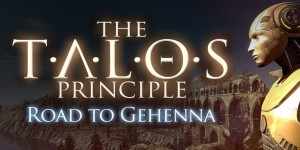Review for Armikrog.
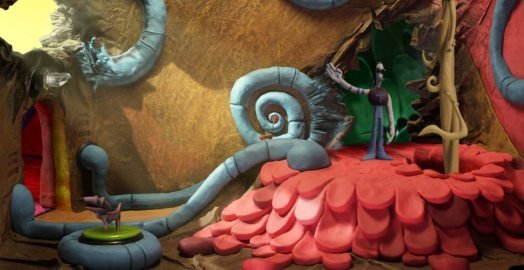
As Armikrog begins, glowing lines form tableaus while an upbeat electronic ballad sets the stage: astronauts Vognaut, Numnaut and Tommynaut have left their planet Ixen in search of P-tonium, a substance that will save their people. But the quest proved deadly, leaving only Tommynaut alive, and players join him and his sidekick Beak-Beak shortly after their spacecraft crashes on a planet made of clay. Actually, most of the gameworld is made of clay – not surprising, as Armikrog is the product of the stick-to-itive minds behind the 1996 stop motion classic The Neverhood. A spiritual successor rather than related sequel, Armikrog is just as unorthodox, containing strikingly weird environments, offbeat characters, whimsical music, daffy puzzle scenarios, and reams of backstory inscribed on a wall. The experience definitely scratches the “give us more of The Neverhood” itch, but it falls a smidgeon short of the high standard set by its predecessor due to multiple irritants.
I played The Neverhood when it first released and expected first-rate scenery in Armikrog. I wasn’t disappointed. The environments are chock full of vivid contrasts and odd juxtapositions. Petal-shaped lips of clay overlap one another, giving a peacock-tail texture to surfaces. One room is dotted and corrugated; in another giant gears lurk beneath pink rosettes. Power generators look like fish with green liquid running through pipes sprouting from their backs. If you click on a window several times, an animated scenario unfolds, pitting a rope-tongued monster against wheelie creatures. Everything has the rough-hewn texture of a world created out of real clay, rather than the computer-generated variety. It’s a wonderful place to explore, with something novel and bizarre just around every corner or upwards via an overhead hatch or down through a yawning hole in the floor.
The main characters are amusingly likeable. Tommynaut has googly eyes and two long tendrils of hair. He’s quick-reflexed, kind, and matter-of-fact, which is a good thing since the whole caboodle around him is nuts. Beak-Beak, his faithful four-legged companion, has a sense of humor, a gruff voice and peculiar attributes: he can sprout wings for aerial tasks, his body is flexible so he can explore tiny passages, and he possesses special vision in shades of black-and-white, revealing items not visible in the usual colorful environments. Dialogs are brief and character interaction is limited.
This is a point-and-click adventure viewed from a third-person perspective. You guide Tommynaut or Beak-Beak by clicking in the direction you’d like them to go, and they’ll move at a snappy pace, though they never run. In addition to walking (and Beaky’s occasional flights), there are two modes of transport: Octovators – octopus-like creatures with long tentacles that move up or down between floors – and cable cars, which run along the inside walls shooting green sparks and whirring like buzz-saws.
An inventive array of sounds and background music enriches Armikrog’s locales. For example, there’s the slurp of the Octovator tendrils, Beak-Beak’s lip-smacking, the popping sound as Tommynaut pulls inventory items out of his body, and the spring-loaded cawing of snout birds. The music sometimes affirms the whimsy of the locations, like a distant hum accompanied by bongo drums and electronic jungle noises. In the first locked room, Tommynaut’s confusion is echoed by sassy horns, moaning voices, and clapping to a tango beat. Late in the game, a melancholic guitar solo evokes loneliness and loss.
Armikrog defies the recent trend toward easier puzzles in adventure games, so if you like to sink your teeth into fierce conundrums, you will be pleased. Power must be turned on and levers and doodads must be correctly placed. The game is literally stuffed with challenges, some of which outshine the more traditional puzzles in The Neverhood and most of which require observing the surroundings for clues, plus a dash of creative thinking. There is no viewable inventory feature, however. When Tommynaut picks up an item, he parks it deep in his chest, and that’s the last you’ll see of it until you click on the object it’s used with.
A multicolored orb sequence is maybe the toughest challenge. It took me more than an hour as I moved color wheels around and shifted the lever to change the arrangement. Finally, in a lightbulb moment, I started thinking more out-of-the-box and tossed aside my misassumptions. I also enjoyed the music obstacle, punctuated by a sound that adds urgency to the puzzle-solving. The annoying noise nudges you toward a fast pace in order to make it stop, though the final kazoo/raspberry-blowing sequence was silly enough that I slowed down and took my time. (Fortunately, you don’t need a trained musical ear for this challenge – being able to recognize parts of a tune is sufficient.)
The game does not hold your hand – in fact, it provides no guidance for what to do next. I spent a good chunk of time wandering clueless, trying this and that, sometimes finding the entrance to a room I’d missed, or a further use to a mechanism… and occasionally resorting to a walkthrough. At one point I realized that I’d encountered a glitch – a lever that should have been popping out of Tommynaut’s chest wasn’t available. I then replayed from a previous saved game, and was able to progress.
Having experienced one glitch, I assumed that a further oddity – the Octovator-narrated cutscenes aren’t in English – arose from another bug of some sort. It turns out that I was wrong. The narration in all these scenes is purposely nonsensical because it’s part of a translation puzzle that won’t be solved until late in the game. The result is that you have no idea what’s going on in these sequences until the very end. I still consider this an opportunity lost, because the chance to understand parts of the story as the game unfolds is purposely mangled.
There is a huge amount of backstory in Armikrog, but the current plot is quite basic: Tommynaut and Beak-Beak must clear the obstacles in one area so they can proceed to the next, hoping to find a way to resume their original quest. They encounter outlandish creatures and alien devices, while gradually discovering the scope and capabilities of the fortress around them. There’s one story event where they discover a new character and try to comfort her by… solving a puzzle and then proceeding to the next area. And happily, there’s a snazzy confrontation near the end that’s affecting, funny, and well-animated. But until very late in the game, any actual narrative relies entirely on The Wall.
Those who have played The Neverhood will now be cheering or groaning, depending on your love/hate relationship with its Hall of Records. Personally, I fall on the “hate” portion of the spectrum. Yet I understand there are gamers out there who enthusiastically embraced the concept of a seemingly endless series of corridors inscribed with genealogical text and have waited almost twenty years to read more absurdist tales about hapless creatures who appear and then disappear. For you, your wait is over.
Absurdities abound in Armikrog’s detailed history, including nasty creatures with bizarre names and quirky habitats. But this time the saga is also a walloping good read that actually makes sense, even to a hidebound story traditionalist like me. I strongly recommend reading Armikrog’s Wall. It’s a long drink, though – nothing but text for a full hour. It adds a lot to the game, but it’s also clearly set apart from gameplay, and many players will balk when confronted with so much reading, however rewarding it may be. (Of course, you could always break up the reading into chunks by occasionally revisiting The Wall as you play through the rest of the game.)
With such loving attention obviously lavished on the graphics, characters, puzzles, and music, it comes as a surprise that the interface is such a mess. It was even worse at launch, though some of the early problems have since been corrected with an update. Of those that remain at time of writing, let’s start with the menus. The save feature and saved games themselves are sneakily hidden in the Options menu. Shall we explore the meaning of the word “options”? Saving your game isn’t optional. Or rather, it is because Armikrog autosaves your progress as you go, but if you don’t go hunting for the saved game where it doesn’t belong, you’d never know it was there. The Options menu, in addition to containing what it oughtn’t, is also bereft of what it ought to have: a way to adjust the audio. I was forced to use the Windows volume adjustment to turn the music up loud enough that I could hear it, which meant that I was blasted with sound whenever the characters spoke.
Random clicking is the chief means of interaction in Armikrog, because the game lacks a smart cursor. I was clicking all over the screen when I happened to discover by accident that Beak-Beak could be controlled separately from Tommynaut. It took another click flurry to figure out that during Beaky’s flight sequences, sprouting wings sometimes requires activating an invisible spot immediately above his back. Clicking on a doorway might send our heroes through it. Or moving to the next locale might call for exploratory mousing at the edge of the screen. Clicking on the Octovator sometimes encourages Tommynaut to climb aboard; more clicking might operate the Octovator or it might cause him to jump off. I only accessed the full text of The Wall when I discovered that holding down the left mouse button and dragging it causes the text to scroll. Subtitles are so frequently out-of-sync with the spoken dialog that I finally turned them off altogether. It’s as if the basic interactive mechanics are supposed to be approached with a spirit of hit-and-miss. Which maybe fits Armikrog’s devil-may-care ethos, but there’s enough trial-and-error while solving puzzles that it shouldn’t creep into the mechanics as well.
With some of these artificial hindrances padding play time, it took me nine hours to complete Armikrog, but I’m happy to report that for the most part the adventure represented a worthy follow-up to its esteemed claymation progenitor. Its environments and soundscape match The Neverhood’s edgy audacity, creating an engagingly off-the-wall world to explore. Tommynaut is a winsome hero and Beak-Beak is a zany cutup. Some of the puzzles are a step up in terms of imaginativeness and difficulty, and The Wall tells a developed, cohesive backstory. Unfortunately, story elements either come in long, non-integrated gulps, or are absent until the endgame. And the interface seems to be channeling state-of-the-art frustration, circa 1996.
Ultimately, Armikrog is a not a game for the impatient, or the serious sophisticate, or the lover of insightful character interaction. But if you’re a collector of mad absurdities, a connoisseur of wacky art, or a hard-bitten puzzle fanatic, then tighten your belt – it’s going to be a rollicking ride.
WHERE CAN I DOWNLOAD Armikrog.
Armikrog. is available at:
- GOG -80%
- HumbleBundle
Our Verdict:
Those who appreciate outrageous locales will be thrilled with Armikrog’s out-of-this-world visuals, and puzzle lovers will find plenty to entertain, but anyone looking for a smooth gameplay experience will find themselves sometimes stuck in the mud.


